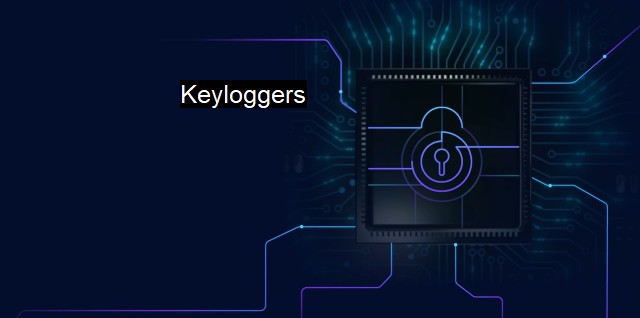What are Keyloggers?
Understanding Keyloggers: How Antivirus Tools Can Protect Against Cyber-Attacks.
Keyloggers, abbreviated versions of "keystroke loggers," encompass a variety of software programs or physical devices that trace and record each keyboard input made on a specific computer. The keyboard inputs can be a direct relationship to the usernames, passwords, credit card numbers, or confidential personal information that end-users frequently insert on their machines when browsing the internet or processing their daily tasks.Keyloggers are intrusively installed onto the victim’s computing device without their knowledge. Typically, keyloggers are one of the most widely used malicious tools in the arsenal of cyber intruders. They serve as covert surveillance tools to monitor, record, and transmit all keystrokes on an infected device and lead the compromised information back to the cybercriminal.
Keyloggers infiltrate computer systems through various means succored by their masters. They can piggyback on spam emails, malvertising, application downloads, and even game demos. Once the user unknowingly installs a keylogger into their system, it fades into the background, secretly recording their keystrokes without alerting the user.
The keystone data harvested by keyloggers can include email compositions, website searches, documents typed, and what's most troubling: personal login credentials. They fetch valuable information like a user's online banking login details, credit card numbers, private conversations, and corporate digital infrastructure data. Hence, keyloggers pose significant threats in both personal and professional circumstances. Instances of identity theft, financial exploitation, blackmail, and corporate espionage are only a fraction of what cybercriminals can orchestrate using keyloggers.
Keyloggers are not wholly destructive. ICT professionals use these devices and programs with benevolent intentions on occasions. IT administrators can deploy keyloggers to troubleshoot technical issues, monitor network usage, or ensure operational productivity on corporate machines.
Nonetheless, in cybersecurity conversations, keyloggers are largely threaded with negative connotations. As the digital era progresses, the prevalence of keylogging activities is snowballing, thereby securing keyloggers a respectful niche on cybersecurity threat landscapes.
Talking about countermeasures, substantial defense can be put in place against keyloggers, and most modern antivirus software plays a pivotal role in tackling the threat. Antivirus solutions come equipped with anti-keylogging features, which allow them to identify known keylogger signatures within the downloaded software or files. They can then alert users, quarantine, or wholly eliminate the keylogger from the system, ensuring the data remains uncompromised for the user.
Contrarily, legitimate keyloggers are usually unrecognized by antivirus software, as they are wrapped in digital signatures that whitelists them as safe programs, making the distinguishing game significantly more challenging. This underlines the importance of deploying an extensive security suite with cutting-edge heuristic analysis for detecting anomalies and signs of freshly baked unidentified malware.
Encouraging safe browsing habits alongside the implementation of a reliable antivirus program can also amplify protection levels. Utilizing complex passwords, enabling two-factor identification, staying away from suspicious websites or surprising email attachments, and regularly updating software can significantly minimize the likelihood of a keylogger intrusion on your computer.
On-screen keyboards and voice-to-text also offer alternative means of data input that fall outside of the ambit of keyloggers. Voice dictation transforms spoken words into written text, meaning a traditional keyboard isn't involved, tossing keyloggers out of the race.
To summarize, while keyloggers pose a significant threat to cybersecurity, taking preventative measures can significantly reduce the risk associated with them. Regular antivirus scans with an advanced, comprehensive security suite, ideal internet hygiene, and choosing more secure input methods can ensure the safety and integrity of your sensitive data. Awareness is the first line of defense, so acknowledging the potential risks of keyloggers is critical in today's digitally-reliant society.

Keyloggers FAQs
What is a keylogger?
A keylogger is a type of malicious software or hardware that records every keystroke made on a computer keyboard, including passwords, credit card numbers, and other sensitive information.How do keyloggers work?
Keyloggers work by intercepting the signals sent from a keyboard to a computer or smartphone. The software or hardware records the strokes and then sends the data to a remote attacker or stores it locally for retrieval later.What are the dangers of keyloggers?
Keyloggers can be used to steal sensitive information such as login credentials, financial information, and private messages. They can also be used to monitor employees or spy on individuals without their knowledge. Once installed, keyloggers can be difficult to detect and remove without specialized software or technical expertise.How can I protect myself from keyloggers?
To protect yourself from keyloggers, it is important to keep your antivirus software and operating system up to date. Be wary of emails and downloads from unknown sources, and avoid clicking on suspicious links or pop-ups. Use unique and complex passwords for each account, and consider using two-factor authentication when possible. You can also use a virtual keyboard or a physical keyboard with encryption capabilities to prevent keyloggers from capturing your keystrokes.| | A | | | B | | | C | | | D | | | E | | | F | | | G | | | H | | | I | | | J | | | K | | | L | | | M | |
| | N | | | O | | | P | | | Q | | | R | | | S | | | T | | | U | | | V | | | W | | | X | | | Y | | | Z | |
| | 1 | | | 2 | | | 3 | | | 4 | | | 7 | | | 8 | | |||||||